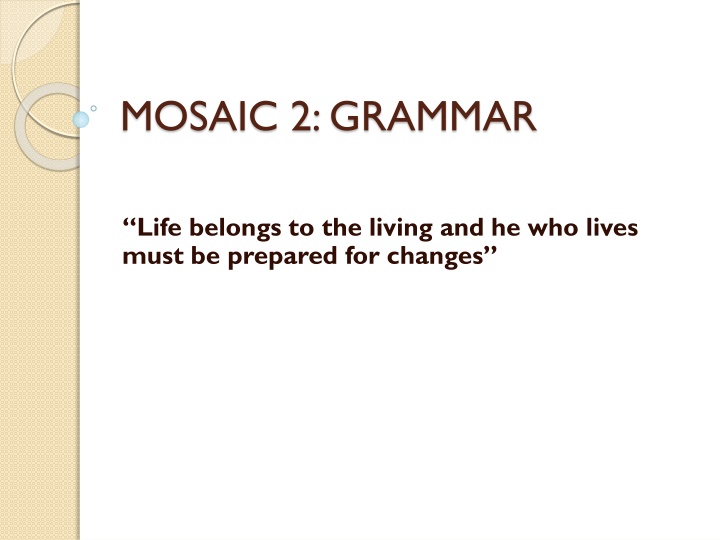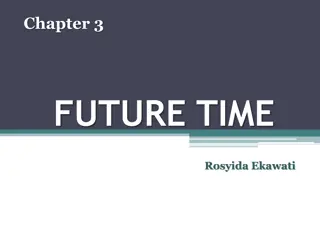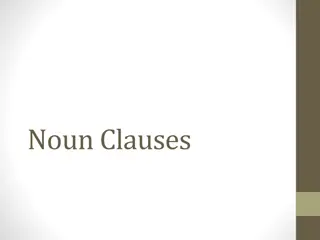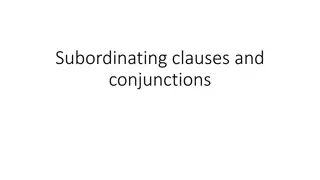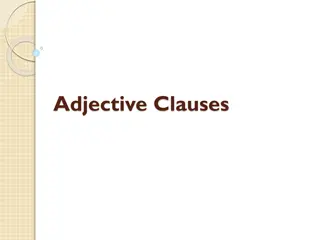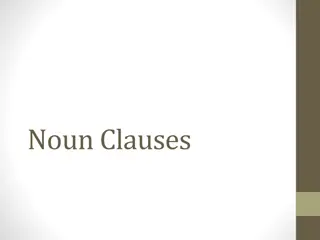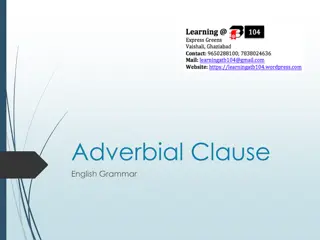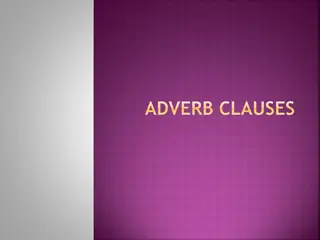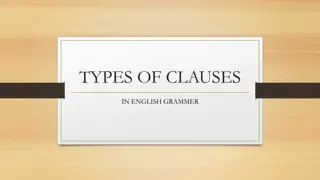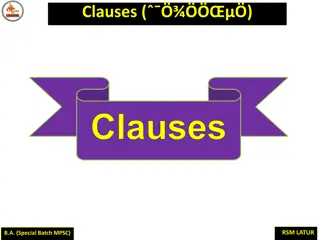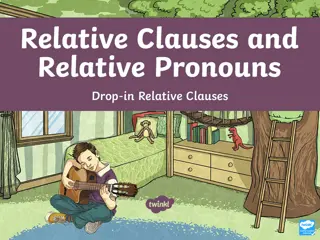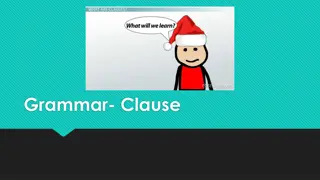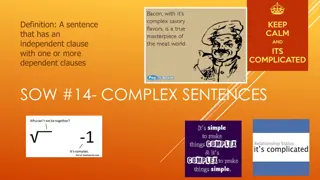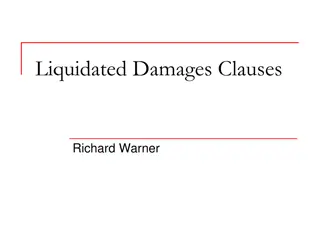Life's Changes: Grammar Transitions & Time Clauses
Life is full of changes, and being prepared for them is crucial. Explore grammar transitions and time clauses in this engaging material, covering adverb clauses of cause, result, time, and more. Practice with examples like learning to walk, climb stairs, and write. Delve into time clauses with present, present perfect, and future tenses, using connecting words effectively. Enhance your understanding of sequence transitions and improve your grasp of language structure effortlessly.
Download Presentation

Please find below an Image/Link to download the presentation.
The content on the website is provided AS IS for your information and personal use only. It may not be sold, licensed, or shared on other websites without obtaining consent from the author.If you encounter any issues during the download, it is possible that the publisher has removed the file from their server.
You are allowed to download the files provided on this website for personal or commercial use, subject to the condition that they are used lawfully. All files are the property of their respective owners.
The content on the website is provided AS IS for your information and personal use only. It may not be sold, licensed, or shared on other websites without obtaining consent from the author.
E N D
Presentation Transcript
MOSAIC 2: GRAMMAR Life belongs to the living and he who lives must be prepared for changes
Chapter 5: Transitions Adverb Clauses of Cause, Result and Time
Part One Clauses and related structures of time: Future Time
5.1 Transitions of Sequence Explanations Common Transitions of Sequence Example Transitions of Sequence are used to tell the order of events or situations. First, second, etc, now, then, finally First, a child will start smiling at its mother. At that time, at that point Later, it will learn to tell the difference between people. For Example, they are commonly used in storytelling and in descriptions of processes. Earlier, later At the same time After that, the child will to imitate its parents actions. They may be used with any verb tense and are sometimes followed by a comma. Meanwhile Afterward, after that
Practice Learning to walk Learning to climb stairs Learning to eat by oneself Learning to write Learning to swim Learning to skip Learning to read
5.2 Time Clauses with the Present, Present Perfect, and Future Tenses. ConnectingWords Explanations Examples After In sentences referring to the future, the verb in the dependant clause can be in the simple After, the baby finishes eating, we ll put her to bed. As soon as Present or present perfect (not the future). The present perfect emphasizes the completion of the first action. I m going to bathe her just as soon as she s finished eating.
5.2 Time Clauses with the Present, Present Perfect, and Future Tenses. ConnectingWords Explanations Examples Before The verb in the main clause uses a future form (will or be going to + verb) or a modal auxiliary (can, may, should, etc.). I ll give her a bath just before I put her to bed. Once Once she goes to bed, we may be able to relax a little.
5.2 Time Clauses with the Present, Present Perfect, and Future Tenses. ConnectingWords Until Explanations The expressions as soon as and just + conjunction (just before, just after) give the strongest sense of immediacy. Once emphasizes the idea of not before. Examples You shouldn t put her to bed until her hair has dried. When When her hair dried, you can put her to bed. As The present continuous is often used in dependent clauses with while or as. It emphasizes an action in progress. I might read her a story while I am waiting for her hair to dry. While
5. 3Time Clauses with the Simple Present and Future Perfect (Continuous) Tenses. WITH CLAUSES Explanations The future perfect (continuous) is sometimes used to emphasize that an action or situation will be completed before a certain time in the future. It is most often used in sentences with by or when. Connecting Words By the time (that) Examples By the time she gets up, she will have slept for ten hours. When When she wakes up, her father will have already left for work.
With Phrases Connecting Words Explanations Examples By + time The prepositions by and within are often used with the future perfect tenses. By is used with an ending time, and within is used with a period of time. By 9:00, she will have been sleeping for several hours. Within + time Within an hour, she will have finished her breakfast.
5. 4 Placement and Punctuation of Adverb Clauses and Phrases Structure Explanations Clauses of Time Most adverb clauses and phrases come either before or after the main clause in a sentence. Placement When the baby wakes up, we ll leave. We ll leave when the baby wakes up. (no comma) After the baby s nap, we ll leave. Phrases of Time Phrases can also come at different points within the sentence, depending on the meaning and the length of the phrase. We ll leave after the baby s nap. (no comma)
5. 4 Placement and Punctuation of Adverb Clauses and Phrases Structure Other Time Expressions Explanations Other time expressions, such as adverbs of frequency, often come between a subject and verb or between verbs, but they almost never come between a verb and its direct object. Placement Before the baby s, we almost always feed him. Before the baby takes a nap, we almost always feed him. We almost always feed the baby before his nap. (no comma) We almost always feed the baby before he takes his nap. (no comma)
Practice Use your own knowledge and experience to follow an infant through its life. Name the child and then use when, before, after, until, or by the time that and a variety of present and future verb tenses. Write at least 8 sentences describing his or her development. Be sure to include emotional, educational and physical factors
Practice Example: When she is 13, she ll be entering high school. By age 16 she ll have finished two years of high school. 1. Age 6 2. Age 13 3. Age 16 4. Age 25 5. Age 40 6. Age 65
Homework: Practice Exercise 7 Talking and Writing about the Future. 1. What are your immediate plans for the future? 2. What are your long-term goals? 3. What do you think you will be like when you are 35?
Part Two Clauses and related structures of time: Present and Unspecified Time
5.5 Time Clauses with the Simple Present, Present Continuous, and Present Perfect Tenses Connecting Words When Explanations Examples When(ever) means any time . When(ever) joins two actions that happen one immediately after the other. When(ever) comes before the earlier action. When people work together, they can accomplish much more. Whenever Whenever people work together, they can accomplish much more. People settle in one area before they develop agriculture. After As soon as Before Once Until Up to the time (that) After, as soon as, before, once, until, and up to the time join actions that occur in sequence. Either the simple present or the present perfect may be used in the dependent clause. Once more people have begun to farm, a food surplus often develops. The present perfect emphasizes the completion of the action. There is very little commerce until the village has grown.
5.5 Time Clauses with the Simple Present, Present Continuous, and Present Perfect Tenses Connecting Words As Explanations Examples As and while join two actions that happen at about the same time. As the population increases, a need for technology develops. While The present continuous can be used in the dependent clause to emphasize the continuous nature of the activity. It may also be used in the main clause. While villages are growing, their societies become more complex. In some societies, while men are hunting, women are working in the fields. Societies have been developing since the first humans walked on earth. Since Since joins a previous action or situation to an action or situation in progress. Commerce has increased steadily ever since people have lived in communities.
Practice 1 The Evolution of Communities
Practice 2 People must have a way of producing a steady supply of food. They can build settled communities. (before, after) 1. People build villages. Large marketplaces develop. (after, when) 2. Commerce expands. Cities develop. (as, as soon as) 3. The social structure of a village remains generally constant. The population reaches 500 to 1,000. (until, up to the time that) 4. Towns grow in size. Their character changes drastically. (when, once) 5. The population grows to several thousand. The impersonal nature of a city begins to develop. (after, as soon as) 6.
Part Three Clauses and Related Structures of Cause and Result
5.6 Adverb Clauses and Related Structures of Cause and Result With Clauses Explanations Because is used in both spoken and written English. Connecting Words Because Examples Because he was a dynamic speaker, crowds always gathered to hear Martin Luther King, Jr. Due to the fact (that) Due to the fact (that) is more formal, while since is less formal. Crowds always gathered to hear Martin Luther king, due to the fact that he was a dynamic speaker. Since Crowds always gathered to hear Martin Luther King, since he was a dynamic speaker.
5.6 Adverb Clauses and Related Structures of Cause and Result With Phrases Explanations These expressions are followed by a noun (phrase) or a gerund. They may not be followed by a subject and verb (a clause). Connecting Words Because of Examples Because of his dynamism, crowds always gathered to hear Martin Luther King. As a Result of Owing to People still admire Dr. King due to his amazing accomplishments. Due to
5.6 Adverb Clauses and Related Structures of Cause and Result With Transitions Connecting Words As a Consequence Explanations Examples Like other transitions, these may begin sentences, or they may be used with a semicolon to join two clauses. In either case, a comma is used after the transition. Gandhi was respected throughout India, as a result, he was given the name Mahatma meaning Great Lord . As a Result Consequently Note that, hence and thus are used primarily in formal English. The other transitions, especially as a result, are used in both formal and informal language. Gandhi was respected throughout India. Thus, he was given the name Mahatma, meaning Great Lord . Hence Therefore Thus
Practice 3: Fill in the blank because, since, because of, due to, or as a result of. his personal strength and dedication, Lenin succeeded in shaping a new Russia. 1. Lenin was totally dedicated, he risked his life to overthrow the tsar. 2. his political position, Lenin went into exile. 3. he needed a way to send information back into Russia, Lenin established the newspaper Iskra ( the spark ) 4.
Practice 3 his power of persuasion, various groups began to support Lenin and his party, the Bolsheviks. ... Lenin believed that only violent revolution could succeed, he fought against more moderate groups. ... Careful planning and the economic and political confusion in Russia, Lenin and the Bolsheviks took control of the government in October of 1917. his role in shaping post-tsarist Russia, Lenin still sparks strong feelings- both negative and positive- even 80 years after his death. 5. 6. 7. 8.
Part Four Clauses and Related Structures of Time: Past Time
5.7 Time Clauses and Phrases with the Simple Past and Past Perfect Tenses. With Clauses Connecting Words Before Explanations Examples Before, by the time (that), and until + the simple past are used with the later event. Before the war began, American colonists had already been rebelling for several years. By the time (that) Adverbs such as already, just, hardly, recently, and scarcely are frequently used with the past perfect tense. By the time (that) the British brought more troops to the colonies, the rebellion had already spread. Until Until the British instituted these taxes, most colonists had been loyal to England. After After + the past perfect is used with the earlier event. When Fights broke out after the British had passed a series of taxes. In some cases, when can be used with either the earlier or later event. The rebellion had already started when the British passed new taxes.
5.7 Time Clauses and Phrases with the Simple Past and Past Perfect Tenses. With Phrases By Remember that phrases do not include a subject / verb combination By 1776, colonists had already been rebelling for several years. Up to Up to 1776, they had not officially decleared war. Within Within seven years, the Americans had gained independence.
5.8 Time Clauses and Phrases with the Simple Past and Past Continuous Tenses With Clauses with the Simple Past Explanations When and as soon as express a direct connection in the time of occurrence of the two events. Connecting Words When (Whenever) Examples Fighting began when the British tried to collect more taxes. As soon as Whenever may be used to describe habitual occurrences. As soon as colonists learned of the fighting rebellion spread rapidly
5.8 Time Clauses and Phrases with the Simple Past and Past Continuous Tenses With Clauses with the Past Continuous (and simple past) Connecting Words Explanations Examples As The past continuous is often used with while or as to describe past actions in progress. While (As) colonists in Boston were fighting the British, colonists in the South were organizing an army. While When When may be used with a clause in the simple past to describe an event that occurred while another even in progress. Colonists in Virginia were planning their own revolt when they received news of the fighting in Boston.
5.8 Time Clauses and Phrases with the Simple Past and Past Continuous Tenses With Phrases Connecting Words Explanations Examples During During is used with phrases. Remember that phrases do not include a subject / verb combination. They received news of the fighting in Boston during a meeting of anti- British colonists.
Review 1 Complete the following sentences by using the simple past, past continuous, or past perfect forms of the verbs in parentheses. 1. While these Pilgrims (settle) in Massachusetts, they (face) many problems. 2. There (be) unfriendly Indians; the winter (be) severe; there (not be) enough food.
Review 1 3. During the first year, many of the pilgrims (die). 4. However, before the year (be) over, the pilgrims (Sign) a treaty with the local Indians. 5. After a few years, they (produce) more food than they could eat. 6. In the years after the pilgrims (arrive), the population (grew) steadily.
Review 1 7. In 1650, 52,000 colonists (live) in North America. 8. By 1759, the population (increase) to over one million. 9. Colonial development (continue) until the revolution (start). 10. When the American Revolution (begin), there (be) 13 colonies.
Practice 2 Combine each pair of sentences using the connecting words in parenthesis. Change the verb tense to the past perfect in one of the clauses in each new sentence. Remember to omit any repetitious information.
Practice 2 1. Most of the colonists felt loyal to Britain. The British started taxing the colonies. (until) 2. The British Parliament increased import taxes. American merchants began to rebel. (after) 3. The British started to collect the new import taxes. The colonists began to organize a rebellion. (by the time) 4. Boston was already a center of rebellion for years. The first armed conflict occurred there in March of 1770. (by the time)
Practice 2 5. The fighting around Boston stopped. The British Parliament passed the Tea Act of 1773, another new set of import taxes. (soon after) 6. British soldiers started enforcing the Tea Act. Boston merchants disguised as Indians attacked a British ship. (After) 7. These merchants secretly boarded the British ship. They dumped over 300 chests of British tea into the ocean. (when)
End of Chapter Complete the rest of the exercises as homework!
Download Slides Online WWW.CLASSROOM.GOOGLE.COM Log in with your SIMAD ACCOUNT Choose Student + Join Class Input class code (t7t6b38)
